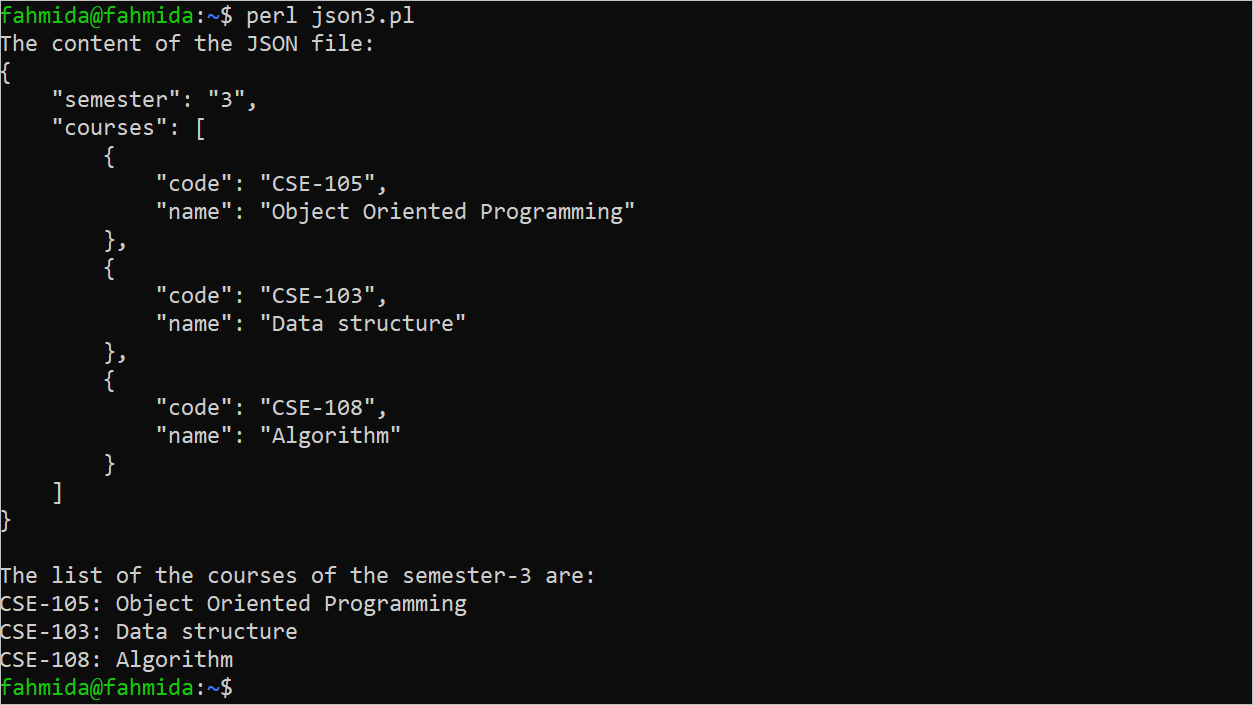Install the JSON Module
You have to install the following JSON module by executing the following command to use the JSON functions that are used in the examples of this tutorial:
Different ways of converting a JSON data into a Perl data structure or vice versa are shown in the next part of this tutorial.
Example 1: Convert a Perl Data Structure into JSON Data
The encode_json() function is used to convert any Perl data structure into a JSON data.
Syntax:
The syntax of the encode_json() function is shown in the following:
Create a Perl file with the following script that converts the content of the hash variable into a JSON text:
#Include JSON module
use JSON;
#Declare a hash variable
my %hash_var = ('4534' => 'HDD', '8967' => 'Monitor', '9045' => 'Mouse', '7845' => 'Scanner',>#Convert the hash data into JSON data
my $json_code = encode_json \%hash_var;
my $json_length = encode_json %hash_var;
#Print the JSON data
print "The JSON code of the hash: \n$json_code\n";
print "The number of JSON properties are $json_length\n";
Output:
The following output appears after executing the script:
Example 2: Convert a JSON Data into a Perl Data Structure
The decode_json() function is used to convert any JSON data into a Perl data structure.
Syntax:
The syntax of the decode_json() function is shown in the following:
Create a Perl file with the following script that converts the content of the JSON variable into the Perl hash data:
use warnings;
use JSON;
use Data::Dumper;
#Declare a JSON variable
$json_data = '{"CSE-105":"Object Oriented Programming","CSE-206":"Advanced Java","CSE-407":"Unix Programming"
$perl_data = decode_json($json_data);
#Print the content of the dumped variable
print "The content of the decoded JSON values:\n";
print Dumper($perl_data);
Output:
The following output appears after executing the script:
Example 3: Convert the Content of the JSON File into a Perl Data
Create a JSON file named “semester.json” with the following content that is used in this example:
"semester": "3",
"courses": [
{
"code": "CSE-105",
"name": "Object Oriented Programming"
},
{
"code": "CSE-103",
"name": "Data structure"
},
{
"code": "CSE-108",
"name": "Algorithm"
}
]
}
Create a Perl file with the following script that reads a JSON data from the “semester.json” file and convert the content of the file into the Perl data structure:
use strict;
use Data::Dumper;
use FileHandle;
use File::Basename;
use JSON;
my $filename = "semester.json";
if(my $file_handler=new FileHandle($filename)) {
#Define the local variable to modify the listed variables while reading a file
local $/ = undef;
#Read the content of the JSON file
my $json_data = <$file_handler>;
#Close the file handler
$file_handler->close();
print "The content of the JSON file:\n";
#Print the content of the JSON file
print $json_data;
#Decode the JSON data
my $decoded_data = decode_json( $json_data);
print "\nThe list of the courses of the semester-$decoded_data->{'semester'} are:\n";
#Print the particular content of the decoded json data
foreach my $value (@{$decoded_data->{"courses"}}) {
print "$value->{'code'}: $value->{'name'}\n";
}
}
else{
#Print error message
print "JSON File does not exist.\n";
}
Output:
The following output appears after executing the script:
Example 4: Write the Perl Data into the JSON File
Create a Perl file with the following script that converts the Perl hash array into the JSON data and store the data in a JSON file named “out_file.json”:
use strict;
use warnings;
use JSON;
use Data::Dumper;
#Define the filename
my $filename = 'out_file.json';
#Define the hash variable
my %hash_data = ('id' => '88979', 'name' => 'Rakib Hossain',
'batch' => 60, 'CGPA' => 3.67);
print "The content of the hash variable:\n";
print Dumper(\%hash_data);
#Declare the array variable that will store the content of the hash variable
my @array;
#Store the hash content in the array
push(@array, \%hash_data);
#Open the file for writing
open(OUT, ">", $filename);
#Write the content of the encoded JSON data into the file
print OUT encode_json(\@array);
close(OUT);
print "\nThe converted JSON data:\n";
#Open the file for reading
open(IN, "<", $filename) or die "File does not exits.\n";
while(<IN>)
{
#Print each line of the file
print $_;
}
close(IN);
#Add newline
print "\n";
Output:
The following output appears after executing the script:
Conclusion
The uses of the encode_json() and decode_json() functions to covert JSON to Perl or Perl to JSON are shown in this tutorial using multiple examples.




